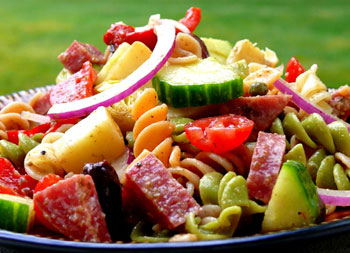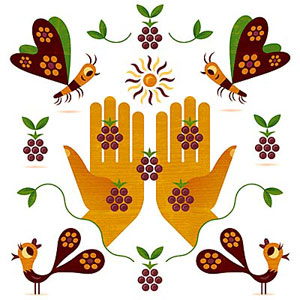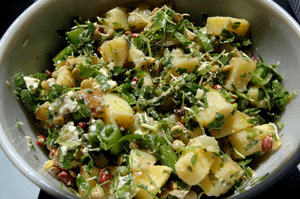 Who doesn't love a good tangy pasta salad? I have tried many, many recipes over the years and I have to say I like the idea of antipasto meets pasta salad.
Who doesn't love a good tangy pasta salad? I have tried many, many recipes over the years and I have to say I like the idea of antipasto meets pasta salad.
Every bite is something different, I love that; crunchy cucumbers, salami, artichoke hearts, kalmata olives and especially the smoked mozzarella. It's quite the yum factor.
This salad is best when made and dressed a day ahead so the flavors can marinate. If you don't have the time to do that, adding a generous splash of red wine vinegar just before serving gives the salad the same bright, tangy flavor.
Make it now or for an upcoming picnic. You will love it.
Spring
Spring
Roasted Asparagus and Grape Tomatoes with Crumbled Feta
For me nothing says "spring" more so than asparagus. As soon as the warm weather of early spring approaches, I start scouring the farmers' market for the first signs of asparagus. I'm always looking for the most slender green spears, ivory white ones, and even the dark purple-almost-black ones. I appreciate all types of asparagus.
I love asparagus cooked any which way except boiled—that's the reason I hated them so much as a kid because they I only ever had them boiled and overcooked. Even though they're not yet available at my most markets just yet, I've already begun cooking with asparagus. I'm just too eager to wait, so until they're available I won't mind the supermarket ones.
For this recipe I roast the asparagus to bring out their sweet taste. Alongside I also roast cherry tomatoes, which will become one of the many toppings for the dish. The dressing is a vinaigrette made from olives and lots of Dijon mustard. And finally the dish gets flourished with salty, tangy feta. This recipe is great as either an appetizer or a side dish.
Boysenberry, a California treasure
From the L.A. Times
 To the uninitiated, the boysenberry may look like a big, blowzy, underripe blackberry, but it is in fact a noble fruit, as distinct from a common blackberry as a thoroughbred is from a mule.
To the uninitiated, the boysenberry may look like a big, blowzy, underripe blackberry, but it is in fact a noble fruit, as distinct from a common blackberry as a thoroughbred is from a mule.
Large, dark purple, juicy and intense, it derives its unique flavor from its complex ancestry: sweetness and floral aroma from its raspberry grandmother, and a winy, feral tang from three native blackberry species.
It's a California classic, emblematic of the joys of growing up in the Southland before it succumbed completely to sprawl. And it's all the more precious, despite its near extinction in this state, because it evokes why people moved here in the first place.
But Boysens can still be found if you know where to look, although their season is brief — late May to early July — and they are so delicate that as a fresh fruit they can be enjoyed at their best only from farmers markets, farm stands and home gardens.
Fresh Herb Potato Salad
 What do Jerusalem artichokes, horseradish and dandelion greens have in common? You'll never guess. Each has a name that is an English version of a foreign name. The Jerusalem artichoke is a variety of sunflower, and the name is derived from "girasole" which means sunflower in Italian. Horseradish is "meerrettich" in German and because "meer" sounds like "mare" the English called it horseradish. Dandelion comes from the French "dent de lion" or lion's tooth, in reference to the jagged leaves of this bitter yet tasty weed.
What do Jerusalem artichokes, horseradish and dandelion greens have in common? You'll never guess. Each has a name that is an English version of a foreign name. The Jerusalem artichoke is a variety of sunflower, and the name is derived from "girasole" which means sunflower in Italian. Horseradish is "meerrettich" in German and because "meer" sounds like "mare" the English called it horseradish. Dandelion comes from the French "dent de lion" or lion's tooth, in reference to the jagged leaves of this bitter yet tasty weed.
Like horseradish, dandelion has quite a bite to it. It can be eaten raw or cooked and like other leafy greens, it is a good source of vitamin A, calcium and iron. But frankly, I'd never cooked with it until this weekend. I found a Jamie Oliver recipe for a potato salad using chopped dandelion greens and I also heard raves about a potato salad with chopped fresh mint, so I decided to combine the two.
Strawberries are Springtimes Favorite Treat
 When my in-laws from Rhode Island were visiting recently, I mentioned that our strawberry season was coming to a close.
When my in-laws from Rhode Island were visiting recently, I mentioned that our strawberry season was coming to a close.
My mother-in-law said, "You mean it's starting, right?
"Nope," I said. "California's strawberry season usually starts in January and ends in June."
"But I don't understand. That's when our strawberry season is just starting," she said.
Exactly.
California is the advanced-gifted child in the classroom of strawberry production. The United States produces about 2 billion pounds of strawberries every year, 90% of which are grown here. Thanks to our temperate climate, we're able to produce strawberries in the wintertime and ship them across the country. That's why people in Massachusetts can buy fresh strawberries at the Stop & Shop in frigid February.
More Articles ...
Welcome to the new One for the Table ...
Our Home Page will be different each time you arrive.
We're sure you'll find something to pique your interest...
